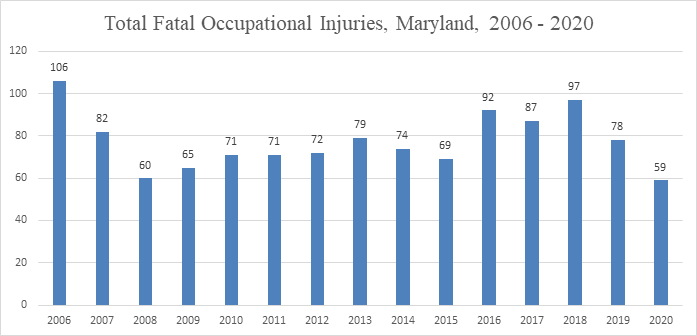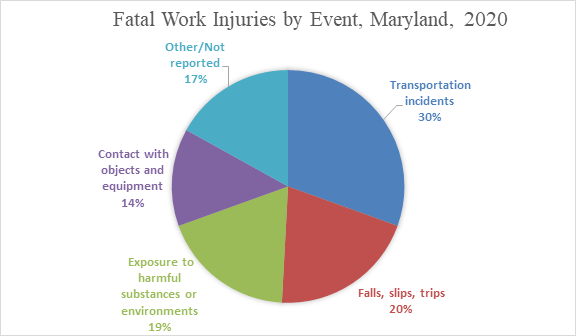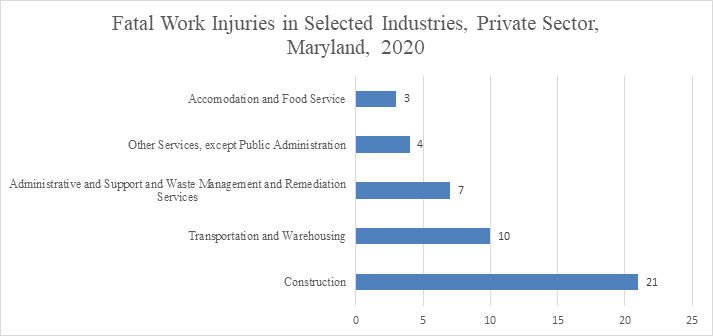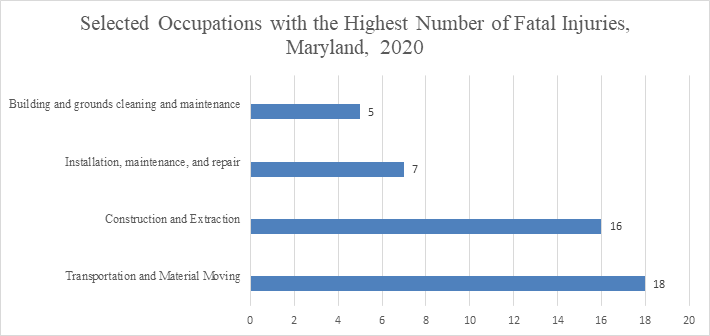Fatal Occupational Injuries In Maryland – 2020 - Research and Statistics - Maryland Occupational Safety and Health (MOSH)
For non fatal injury data in MD, please visit: U.S. Bureau of Labor Statistics
Fatal work injuries totaled 59 in 2020 for Maryland according to the latest fatality census results from the Bureau of Labor Statistics’ Census of Fatal Occupational Injuries (CFOI). The number of work related fatalities for 2020 were down from 78 in the previous year. Since 1992, fatal occupational injuries in Maryland have ranged from a high of 106, reported in 2006, to a low of 59, reported this year. Certain fatal events are not covered under the Maryland Occupational Safety and Health agency’s investigative oversight including cases of workplace homicide and suicide; certain transportation events, such as aircraft, rail, and highway crashes; and fatalities to the self-employed. The Census of Fatal Occupational Injuries does include these cases, therefore the work fatality count reported on CFOI is significantly higher.
Nationwide, a total of 4,764 fatal work injuries were recorded in 2020, a 10.7-percent decrease from the 5,333 fatal injuries in 2019. The national total of work fatalities for 2020 represented the lowest annual number since 2013.

Source: Maryland Division of Labor and Industry in cooperation with the U.S. Bureau of Labor Statistics, CFOI Program, December 2021.
In Maryland, transportation incidents was the most frequent type of incident resulting in 18 fatal work injuries. Falls, slips, and trips accounted for 12 fatalities and exposure to harmful substances or environments accounted for 11 fatalities. These three major categories accounted for nearly 70 percent of all workplace fatalities in the state. The number of worker deaths from transportation incidents dropped from 25 in 2019, but with the exception of two years (1995 and 2014), transportation events have remained the most frequent cause of death for workers in Maryland; in 2018, it tied with exposure to harmful substances or environments for the most frequent. Worker fatalities due to falls, slips, and trips decreased from 17 in 2019, while fatalities from exposure to harmful substances or environments remained the same at 11. Unintentional overdoses due to nonmedical use of drugs or alcohol while at work accounted for 5 of the 11 worker deaths among exposure to harmful substances or environments in 2020.

Source: Maryland Division of Labor and Industry in cooperation with the U.S. Bureau of Labor Statistics, CFOI Program, December 2021.
Note: Total may not equal 100 percent due to rounding.
Nationally, transportation incidents fell 16 percent to 1,778 in 2020 from 2,122 in 2019 but remained the most frequent fatal workplace event in 2020, accounting for 37 percent of all fatal work injuries. Falls, slips, and trips was the second-most common fatal event (17 percent), followed by contact with objects and equipment (15 percent), and violence and other injuries by persons or animals (15 percent).

Source: Maryland Division of Labor and Industry in cooperation with the U.S. Bureau of Labor Statistics, CFOI Program, December 2021.
Industry
The private construction industry had the largest numbers of fatalities in Maryland in 2020 with 21, up from 15 in 2019. Falls, slips, and trips accounted for 9 of the 21 fatalities in this industry. The private sector transportation and warehousing had 10 worker fatalities, down from 12 in 2019, followed by administrative and support and waste management and remediation services which accounted for 7 fatal workplace injuries.

Source: Maryland Division of Labor and Industry in cooperation with the U.S. Bureau of Labor Statistics, CFOI Program, December 2021.
Occupation
Transportation and material moving occupations had the highest number of fatalities with 18, with the majority of the fatalities within this group being motor vehicle operators accounting for 13 of the fatalities. Construction and extraction occupations had the second highest number of fatalities with 16.
Maryland workers in transportation and material moving occupations and construction and extraction occupations accounted for 58 percent of the state’s work related fatalities as compared to the national percentage of 47. In Maryland, the most frequent event among transportation and material moving occupations was transportation incidents, while the most frequent event among construction and extraction occupations was falls, slips, and trips, both holding a 50-percent share within those respective occupations.

Source: Maryland Division of Labor and Industry in cooperation with the U.S. Bureau of Labor Statistics, CFOI Program, December 2021.
Additional highlights
- Women accounted for 15 percent of the work-related fatalities in Maryland, higher than the 8-percent national share.
- White, non-Hispanic workers accounted for 37 percent of those who died from a workplace injury in the state while Hispanic or Latino workers accounted for 32 percent. Nationwide, these groups accounted for 61 percent and 23 percent of work-related deaths, respectively.
- Workers 25-54 years old accounted for 64 percent of the state’s work-related fatalities in 2020, higher than the 56 percent of on-the-job fatalities nationally.
- Of the 59 fatally-injured workers in Maryland, 86 percent worked for wages and salaries; the remainder were self-employed.
Coronavirus (COVID-19) Pandemic and the Census of Fatal Occupational Injuries
CFOI reports fatal workplace injuries only. These may include fatal workplace injuries complicated by an illness such as COVID-19. Fatal workplace illnesses not precipitated by an injury are not in scope for CFOI. CFOI does not report any illness related information, including COVID-19. Additional information is available at www.bls.gov/covid19/effects-of-covid-19-on-workplace-injuries-and-illnesses-compensation-and-occupationalrequirements.htm.
Scope and Program Technical Notes
The Maryland Census of Fatal Occupational Injuries (CFOI) program collects and publishes statistics on all fatal work injures occurring in the State of Maryland. Maryland CFOI is conducted within the Maryland Department of Labor, Division of Labor and Industry in cooperation with the U.S Department of Labor, Bureau of Labor Statistics. CFOI’s published results are the U.S. government’s official tally of workplace fatalities for the nation. Maryland has participated in the CFOI program every year since the program’s inception in 1992.
CFOI provides for a complete accounting of all fatal work injuries that occur in Maryland each year. The program uses diverse data sources from a variety of federal, state, and local government administrative records, as well as the media, in order to substantiate and profile fatal work injuries. CFOI includes data for all workplace fatalities regardless of whether the fatality was under the regulatory authority of the Maryland Occupational Safety and Health agency or other federal and state agencies. Any comparisons, therefore, between the CFOI program’s counts and those released by other agencies or sources should take into account the different coverage requirements and definitions being used.
For a fatality to be included in this census, the decedent must have been employed (defined as working for pay, compensation, or profit) at the time of the event, engaged in a legal work activity, or present at the site of the incident as a requirement of his or her job. Fatalities to volunteers and unpaid family workers who perform the same duties and functions as paid workers are also included in the count. These criteria are generally broader than those used by state and federal agencies administering specific laws and regulations. (Fatalities that occur during a person’s normal commute to and from work are excluded from the census counts.)
Data presented in this release include deaths occurring in 2020 that resulted from traumatic occupational injuries. An injury is defined as any wound or damage to the body resulting from acute exposure to energy, such as heat, electricity, or impact from a crash or fall, or from the absence of such essentials as heat or oxygen, caused by a specific event or incident within a single workday or shift. Fatal injuries included in the fatality census are open wounds; intracranial and internal injuries; heatstroke; hypothermia; asphyxiation; acute poisonings, resulting from short-term exposures limited to the worker’s shift; suicides and homicides; and work injuries listed as underlying or contributory causes of death.Table A-1 Industry by event or exposure (Excel)
Table A-5 Occupation by event or exposure (Excel)
Table A-7 Worker characteristics by event or exposure (Excel)
Table A-9 Event or exposure by major private industry division (Excel)
For non fatal injury data in MD, please visit: U.S. Bureau of Labor Statistics
Division of Labor and Industry
Maryland Occupational Safety and Health (MOSH)
10946 Golden West Drive,
Suite 160
Hunt Valley, MD 21031
Phone: 410-527-4499
Fax: 410-527-4481
e-mail: MOSH.Complaints@Maryland.gov
Directions to the Hunt Valley Training Center
Select the MD Statistical Information for a calendar year:
- Maryland Statistical Information 2023
- Maryland Statistical Information 2022
- Maryland Statistical Information 2021
- Maryland Statistical Information 2020
- Maryland Statistical Information 2019
- Maryland Statistical Information 2017
- Maryland Statistical Information 2016
- Maryland Statistical Information 2015
- Maryland Statistical Information 2014
- Maryland Statistical Information 2013
- Maryland Statistical Information 2012
- Maryland Statistical Information 2011
- Maryland Statistical Information 2010
- Maryland Statistical Information 2009
